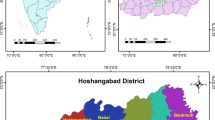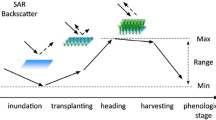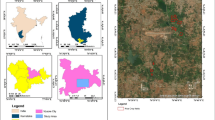Abstract
A national level project on kharif rice identification and acreage estimation is being carried out successfully for several states in the country. A similar methodology based on the temporal profile for identification and delineation of various land cover classes has been followed for the Rabi rice acreage estimation. To define rabi rice, rabi season in India starts from November — February to March — June. Though the main growing season is predominantly winter but the uncertainty of getting cloud free data during the season has resulted in the use of microwave data. A feasibility study was taken up for early forecasting of the rabi rice area using microwave data. Hierarchical decision rule classification technique was used for the identification of the different land cover classes. Land preparation, puddling and transplantation were the reasons for the specific backscatter of rice growing areas. The increase or decrease in the SAR backscatter due to progress in the crop phenology or due to delayed sowing respectively forms the basis for identifying the rice areas. In addition the potential of optical data of a later date has been utilized in the form of various indices from bands including MIR to distinctly separate the late sown areas and also the puddled areas from other areas. This study emphasizes the synergistic use of SAR and optical data for delineating the rabi rice areas which is of immense use in giving an early forecast.
Similar content being viewed by others
References
Agricultural situation in India (2004) Publication Division. Directorate of Economics and Statistics, Department of Agriculture and Co-operation, Ministry of Agriculture. Govt. of India.
Chakraborty M and Panigrahy S (2000) A processing and software system for rice crop inventory using multi-date RADARSAT ScanSAR data. ISPRS Journal of Photogrammetry and Remote Sensing 55(2): 119–128
Chakraborty M and Panigrahy S and Sharma SA (1997) Discrimination of Rice Crop grown under different cultural practices using Temporal ERS-1 SAR data. ISPRS Journal of Photogrammetry and Remote Sensing 52(2): 183–191
Hoogeboom P (1983) Classification of Agricultural Crops in Radar Images. IEEE Transactions on Geoscience and Remote Sensing GE-23(2): 329–336
Kurosu T, Fujita M and Chiba K (1995) Monitoring of rice crop growth from space using the ERS-1 C — band SAR. IEEE Transactions on Geoscience and Remote Sensing 33(4): 1092–1096
Patel NK, Medhavy TT, Patnaik C and Hussain A (1995) Multi Temporal ERS-1 SAR Data for Identification of Rice Crop. Journal of Indian Soc Remote Sens 23(2): 33–39
Patnaik C, Chakraborty M, Panigrahy S, Parihar JS (2007) National Kharif Rice Forecasting Using Radarsat Multi Temporal Scansar Data. Scientific Report-. EOAM/SAC/FASAL/SN/ 08 /2007
Premlata M and Rao PPN (1994). Crop acreage estimation using ERS-1 SAR data. J Indian Soc Remote Sens 22(3): 139–147
Author information
Authors and Affiliations
Corresponding author
About this article
Cite this article
Haldar, D., Patnaik, C. Synergistic use of multi-temporal Radarsat SAR and AWiFS data for Rabi rice identification. J Indian Soc Remote Sens 38, 153–160 (2010). https://doi.org/10.1007/s12524-010-0006-x
Received:
Accepted:
Published:
Issue Date:
DOI: https://doi.org/10.1007/s12524-010-0006-x




